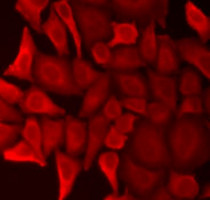ARG41104
anti-CD84 antibody
anti-CD84 antibody for ICC/IF,Western blot and Human
Overview
| Product Description | Rabbit Polyclonal antibody recognizes CD84 |
|---|---|
| Tested Reactivity | Hu |
| Tested Application | ICC/IF, WB |
| Host | Rabbit |
| Clonality | Polyclonal |
| Isotype | IgG |
| Target Name | CD84 |
| Antigen Species | Human |
| Immunogen | Recombinant fusion protein corresponding to aa. 22-225 of Human CD84 (NP_003865.1). |
| Conjugation | Un-conjugated |
| Alternate Names | hCD84; Leukocyte differentiation antigen CD84; Hly9-beta; CD antigen CD84; LY9B; mCD84; Cell surface antigen MAX.3; SLAM family member 5; SLAMF5; Signaling lymphocytic activation molecule 5 |
Application Instructions
| Application Suggestion |
|
||||||
|---|---|---|---|---|---|---|---|
| Application Note | * The dilutions indicate recommended starting dilutions and the optimal dilutions or concentrations should be determined by the scientist. | ||||||
| Positive Control | THP-1 | ||||||
| Observed Size | 65 kDa |
Properties
| Form | Liquid |
|---|---|
| Purification | Affinity purified. |
| Buffer | PBS (pH 7.3), 0.02% Sodium azide and 50% Glycerol. |
| Preservative | 0.02% Sodium azide |
| Stabilizer | 50% Glycerol |
| Storage Instruction | For continuous use, store undiluted antibody at 2-8°C for up to a week. For long-term storage, aliquot and store at -20°C. Storage in frost free freezers is not recommended. Avoid repeated freeze/thaw cycles. Suggest spin the vial prior to opening. The antibody solution should be gently mixed before use. |
| Note | For laboratory research only, not for drug, diagnostic or other use. |
Bioinformation
| Database Links | |
|---|---|
| Gene Symbol | CD84 |
| Gene Full Name | CD84 molecule |
| Background | This gene encodes a membrane glycoprotein that is a member of the signaling lymphocyte activation molecule (SLAM) family. This family forms a subset of the larger CD2 cell-surface receptor Ig superfamily. The encoded protein is a homophilic adhesion molecule that is expressed in numerous immune cells types and is involved in regulating receptor-mediated signaling in those cells. Alternate splicing results in multiple transcript variants. [provided by RefSeq, Oct 2011] |
| Function | Plays a role as adhesion receptor functioning by homophilic interactions and by clustering. Recruits SH2 domain-containing proteins SH2D1A/SAP. Increases proliferative responses of activated T-cells and SH2D1A/SAP does not seen be required for this process. Homophilic interactions enhance interferon gamma/IFNG secretion in lymphocytes and induce platelet stimulation via a SH2D1A/SAP-dependent pathway. May serve as a marker for hematopoietic progenitor cells. [UniProt] |
| Cellular Localization | Cell membrane; Single-pass type I membrane protein. [UniProt] |
| Calculated MW | 39 kDa |
| PTM | Phosphorylated by tyrosine-protein kinase LCK on tyrosine residues following ligation induced by agonist monoclonal antibody. The association with SH2D1A is dependent of tyrosine phosphorylation of its cytoplasmic domain. Phosphorylated on Tyr-296 and Tyr-316 following platelet aggregation. Phosphorylated on tyrosine residues upon high affinity immunoglobulin epsilon receptor aggregation in mast cells. N-glycosylated. [UniProt] |
Images (2) Click the Picture to Zoom In







